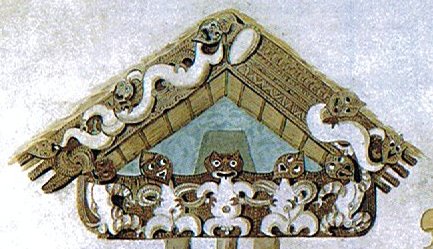|
If we add 64 days - which should be the proper procedure - then day 290 will become day 354 (= 12 * 29.5):
Day 363 should be the day of Rogo, and in Pa11-31 we can see no eyes. The following day (364 = 354 + 10 = 13 * 14 * 2) obviously is important, because at its noon the tablet must be turned around. The season of 4 is changing into the season of 3 - we can read from the feather signs at left respectively right in Pa11-31. The day number indicates the end of old sun because 363 - 64 = 299. 4 feathers are hanging down from the rising fish in Pa11-24, not 3. The hanging maro sign does not refer to the end of summer but to the end of autumn. With a cycle of 400 days and 3 * 64 = 192 as the primary measure of spring sun power there could be an overlap ('conjunction') between the 4th multiple of 64 (beyond 192) and the first 48 days of the following 4 * 52 = 208 days. 400 - 192 = 208 = 8 * 26 and 192 + 64 = 256 = 8 * 32. 256 - 208 = 48 = 8 * 6:
Maybe the text is 'shifting gears' between Pa11-22 (to be read primarily as a reference to the afternoon of day 231 + 64 = 295) and Pa11-23 (to be read primarily as a reference to the forenoon of day 359). If so, then the burned surface of line Ha11 has been strategically located, because it eliminates any questions about where the text is 'shifting gears' (which I assume could have been a common practice among the rongorongo writers):
From the above it follows that also tagata at left in *Ha11-28 must be 'to the right' of the time gap. This tagata will then not be parallel with the figures in Pa11-22 and Qb2-10. The earth (henua) suddenly becomes dark (hatchmarks), because the 'fire' (sun) has disappeared behind torrents of rain. The origin of the practice of dipping people into water at midsummer presumably is to motivate also the sun to take a bath - the heat is drying everything up and rain is needed. To the right of the 'egg' at the apex comes a vacant space, probably illustrating how sun light suddenly has disappeared behind rain clouds (which surely must arrive after a period of intense heat when much water has been evaporated):
|
|||||||||||||||||||||||||||||||||||||||||||||||||||||||||||||||||||||||||||||||||||||||||||||||||||||||||||||||||||||||||||||||||||||||||||||||||||||||||||























